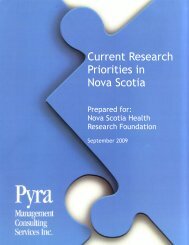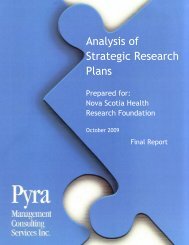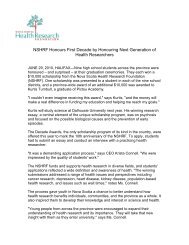Major Health Issues in Nova Scotia: An Environmental Scan
Major Health Issues in Nova Scotia: An Environmental Scan
Major Health Issues in Nova Scotia: An Environmental Scan
Create successful ePaper yourself
Turn your PDF publications into a flip-book with our unique Google optimized e-Paper software.
# Reference Brief Notes<br />
Message design strategies to raise public<br />
awareness of social determ<strong>in</strong>ants of health<br />
and population health disparities. Milbank Q.;<br />
2008; 86(3):481-513.<br />
raise awareness of social determ<strong>in</strong>ants of health (SDH) and health<br />
disparities: message fram<strong>in</strong>g, narratives, and visual imagery. Evidence<br />
suggests that population health advocates should frame messages to<br />
acknowledge a role for <strong>in</strong>dividual decisions about behaviour but<br />
emphasize SDH. The authors conclude that the field of<br />
communication science offers valuable <strong>in</strong>sights <strong>in</strong>to ways that<br />
population health advocates and researchers might develop better<br />
messages to shape public op<strong>in</strong>ion and debate about the social<br />
conditions that shape the health and well-be<strong>in</strong>g of populations. This<br />
article offers a broad framework for these efforts and concludes with<br />
an agenda for future research to ref<strong>in</strong>e message strategies to raise<br />
32. Obrist,B, Iteba,N, Lengeler,C, et al. Access<br />
to health care <strong>in</strong> contexts of livelihood<br />
<strong>in</strong>security: A framework for analysis and<br />
action. PLoS Med.; 2007; 4(10):1584-8.<br />
33. Olshansky,E, Sacco,D, Braxter,B, et al.<br />
Participatory action research to understand<br />
and reduce health disparities. Nurs.Outlook;<br />
2005; 53(3):121-6.<br />
34. Politzer,RM, Yoon,J, Shi,L, et al. Inequality<br />
<strong>in</strong> america: The contribution of health<br />
centers <strong>in</strong> reduc<strong>in</strong>g and elim<strong>in</strong>at<strong>in</strong>g<br />
disparities <strong>in</strong> access to care. Med.Care<br />
Res.Rev.; 2001; 58(2):234-48.<br />
35. Ra<strong>in</strong>ham,D. Do differences <strong>in</strong> health make a<br />
difference? A review for health<br />
policymakers. <strong>Health</strong> Policy; 2007; 84(2-<br />
3):123-32.<br />
36. Rew,L, Hoke,MM, Horner,SD, et al.<br />
Development of a dynamic model to guide<br />
health disparities research. Nurs.Outlook;<br />
2009; 57(3):132-42.<br />
37. Ruger,JP. Reth<strong>in</strong>k<strong>in</strong>g equal access: Agency,<br />
quality, and norms. Glob.Public.<strong>Health</strong>.; 2007;<br />
2(1):78-96.<br />
awareness of SDH and health disparities.<br />
n/a<br />
This article describes the method of PAR, supports the<br />
appropriateness of PAR to learn about and reduce health disparities,<br />
and then presents some specific examples of research projects that<br />
have employed or are plann<strong>in</strong>g to employ PAR.<br />
This article reviews the literature that demonstrates a relationship<br />
between access to appropriate health care and reductions <strong>in</strong> health<br />
status disparities. Us<strong>in</strong>g comprehensive site-level data, patient<br />
surveys, and medical record reviews, the authors present an<br />
evaluation of the ability of health centers to provide such access.<br />
Evidence suggests that health centers are successful <strong>in</strong> reduc<strong>in</strong>g and<br />
elim<strong>in</strong>at<strong>in</strong>g health access disparities by establish<strong>in</strong>g themselves as<br />
their patients' usual and regular source of care. This relationship<br />
portends well for reduc<strong>in</strong>g and elim<strong>in</strong>at<strong>in</strong>g health status disparities.<br />
While many societies have made remarkable progress <strong>in</strong> population<br />
health improvements, health <strong>in</strong>equalities rema<strong>in</strong> as a central concern<br />
to health policy. There is substantial evidence to show that<br />
differences <strong>in</strong> health achievements and access to health care are<br />
<strong>in</strong>creas<strong>in</strong>g both with<strong>in</strong> and among societies. Understand<strong>in</strong>g the<br />
fundamental causes underly<strong>in</strong>g the existence of health <strong>in</strong>equalities is<br />
useful for guid<strong>in</strong>g health policy as it provides a direction to guide<br />
resource allocation and the target<strong>in</strong>g of policy <strong>in</strong>terventions. The<br />
purpose of this paper is to review current perspectives and methods<br />
<strong>in</strong> the assessment of health <strong>in</strong>equalities with particular relevance to<br />
public health policymakers and practitioners.<br />
The purpose of this article is to describe the evolution of a<br />
conceptual model for the study of health disparities. The model,<br />
based on a review of literature, was developed to guide 19 pilot<br />
studies funded by the Texas-New Mexico P20 Southwest Partnership<br />
Center for Nurs<strong>in</strong>g Research on <strong>Health</strong> Disparities. Reflection on<br />
these studies, their respective methodologies, and f<strong>in</strong>d<strong>in</strong>gs resulted <strong>in</strong><br />
a revised model to guide further studies of communities experienc<strong>in</strong>g<br />
health disparities.<br />
At the philosophical level, few have sought to understand why<br />
differences <strong>in</strong> healthcare quality are morally so troubl<strong>in</strong>g. This paper<br />
argues for reth<strong>in</strong>k<strong>in</strong>g equal access <strong>in</strong> terms of an alternative ethical<br />
aim: to ensure the social conditions <strong>in</strong> which all <strong>in</strong>dividuals have the<br />
capability to be healthy. This perspective requires that we exam<strong>in</strong>e<br />
<strong>in</strong>justices not just by the level of healthcare resources, but by the: (1)<br />
quality of those resources and their capacity to enable effective health<br />
function<strong>in</strong>g; (2) extent to which society supports health agency so











